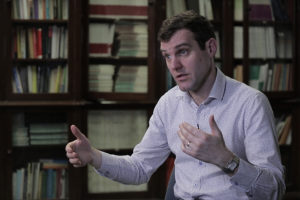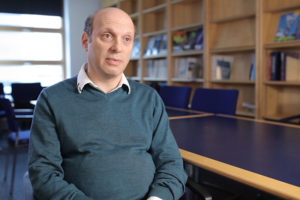Tropical Cyclone
Meteorologist Chris Brierley on the tropical cyclogenesis, the distribution of tropical cyclones on the planet...
The video is a part of the project British Scientists produced in collaboration between Serious Science and the British Council.
I’m going to talk about radiative forcing of climate change. In order to understand that, we need to understand about the radiation balance of the Earth. If we consider the Earth as a planet sitting bathed in solar radiation, we can see that it’s going to absorb some of the solar radiation. On average ,if there’s no climate change and if we average over the globe and over a year the amount of solar radiation absorbed, the heat of that, must equal the amount of heat radiation leaving. There’s a radiation balance between the solar radiation absorbed and the heat radiation emitted.
Distributed over the globe, of course, that’s quite different. It’s going to be different at different parts of the globe, but let’s just think of the Earth of a sort of planet sitting in space. That will vary over the year. As the Earth moves around the Sun there will be different parts of the planet receiving different amounts of solar radiation. Geographically, it will vary too. But when we look at the planet as a whole, we see the radiation coming in equals a radiation going out. When we talk about radiative forcing of climate change, we’re going to think about a disbalance in this radiation budget.
First of all, I’ll talk a little bit about what happens to the radiation inside the climate system. The sun’s radiation arrives on the outside of the atmosphere and it will penetrate the atmosphere, about half of it gets through to the surface and heats the surface, about a third or a quarter gets scattered back to space, and the rest of its absorbed within the atmosphere. When it heats the surface, the surface gets hot and that emits heat radiation, and that heat radiation starts to transfer up through the atmosphere, but it is strongly absorbed by the atmosphere and in particular by the gases that become known to be called as greenhouse gases. The strongest greenhouse gas is water vapor. That’s perfectly natural in the atmosphere and that will absorb a significant proportion of the amount of radiation that’s leaving the surface.
With all that being equal that the surface temperature of the Earth is 30 degrees warmer, because there’s an atmosphere there, because it’s absorbing the heat radiation, it’s acting like a blanket. It would be the case if there was no atmosphere and it was just a planet sitting bathed in solar radiation. We can see now that the radiation balance at different levels in the atmosphere is very important to determining the climate and determining the surface temperature on the Earth.
Other factors that affect the radiation balance are the reflectivity of the planet. I mentioned that some of the solar radiation was getting scattered back to space. That is by clouds and also by bright surfaces like ice and deserts, and also particulates in the atmosphere will reflect sunshine back to space. So, any changes in those properties will also affect the climate.
When we think about climate change and radiative forcing of climate change, we’re thinking about how any of these things affect the radiation balance. The concept of radiative forcing is very useful because what we found by experiments and observation is that if you get something that forces a net imbalance in the radiation at the top of the atmosphere, that is linearly related to a change in surface temperature. For example, the global average radiation coming in and radiation going out is about 240W/m2 over the Earth surface. If you change that by 4W/m2, you will get a global surface temperature change of something like 2 degrees.
It doesn’t matter what’s causing the forcing – just the magnitude will give you that result. It’s a very useful concept, because it means if we can calculate the radiation change, the radiative forcing, we get a very approximate, it is approximate, but it is the first idea of what the surface temperature response will be. We don’t have to run the very complicated climate models and use loads and loads of computer time to get this very first idea of what the magnitude of the effect will be. We calculate potential radiative forcing due to these different factors and we can thereby compare their different effects.
A very obvious one would be if the Sun suddenly put out more energy that would be a positive radiative forcing. If we put more carbon dioxide and other greenhouse gases into the atmosphere, that traps the heat radiation. That’s a positive radiative forcing. If we put more particulates in the atmosphere or brighten the surface somehow – you can brighten the surface by chopping down trees and making more deserts – that will be more reflection of solar radiation back to space. That’s a negative radiative forcing. We can calculate the radiative forcing due to any of these different factors, and that will give us an idea of what the climate change impact globally averaged at the surface will be. It doesn’t give us any details, but it gives us an order of magnitude.
It’s very useful when we’re thinking about new gases. For example, you will have heard of chlorofluorocarbons because they’re the gases that were implicated and indeed responsible for causing ozone depletion higher in the stratosphere over the Antarctic, depleting ozone. They have now been banned from production because of the harm that they’re doing to the ozone layer. But another very important physical property of these chlorofluorocarbons is that they have a very strong greenhouse effect and they’re very long-living. While they’re not contributing much to the greenhouse effect at the moment, it is a significant amount and it will remain there until they very slowly die away.
If we understand if people are going to produce different sorts of gases in the future, we can identify what their radiative forcing is, we can predict what their climate change impact might be. Looking back in the past we can calculate radiative forcing due to natural factors and also due to human factors, and see how we think that might have affected global temperature. And then we can compare that with the temperature records and see if the radiative forcing is actually working, as we have defined it.
So, we can look and see how we think a solar radiation varied, we can also look at volcanic eruptions, of course, that’s possibly natural, nothing to do with human activity, but they do have a large temporary effect on climate. If you get a big volcanic eruption, it throws a lot of stuff up into the atmosphere and that stuff gets high enough, it sits in the stratosphere and it can stay there for two years reflecting the sunshine back to space. There are very clear records of temperature at the surface which show cooling in response to big volcanic eruptions. That’s perfectly natural. Then we can look at how changes in the greenhouse gases have occurred over time, in particular, carbon dioxide, but also methane, nitrous oxide, ozone and the chlorofluorocarbons, and other gases – how those concentrations have changed in time. We can look at their radiative forcing values and consider how much they must have contributed to temperature change in the past.
Given the uncertainties on those values and also the uncertainties on the temperature records, we find that they match fairly well. This means that if we can predict into the future what the radiative forcing of different factors is going to be – very difficult to predict volcanoes, very difficult to predict the Sun, but we can have variations on those as we choose – we can have an idea of what perhaps the range of CO2 values might be, or methane, and to predict the radiative forcing. That will give us a very gross first order idea of what the global surface temperature change will be. It won’t tell us what would happen in different regions of the globe. To understand that we need to use the climate models that can predict regional variations. But it will give us a global picture. Radiative forcing is a very useful concept.
There’s an even further complex addition to that problem, which is how long the clouds live. All clouds need condensation nuclei. Perfectly natural clouds will form around perhaps see salt aerosol or dust aerosol, and that’s where the clouds form in the natural climate. If you have more aerosols, for example, due to human activity, you’ve got a more condensation nuclei, you may have the same amount of water vapor, but more nuclei. So, what happens is you get more but smaller drops. The smaller drops are better at reflective sunshine to space and they are also longer-lived in the cloud. They’re less likely to fall out as rainfall. So, you can see that there’s all these knock-on effects in terms of the physical properties and the longevity of the cloud which we need to understand a bit further in order to predict how the climate might respond to these factors in future.

Meteorologist Chris Brierley on the tropical cyclogenesis, the distribution of tropical cyclones on the planet...

Physicist Federico Capasso on semiconductor materials, industrial process control, and beam engineering

Molecular Neurogeneticist David Rubinsztein on the Kennedy disease, CAG repeats, and autophagy